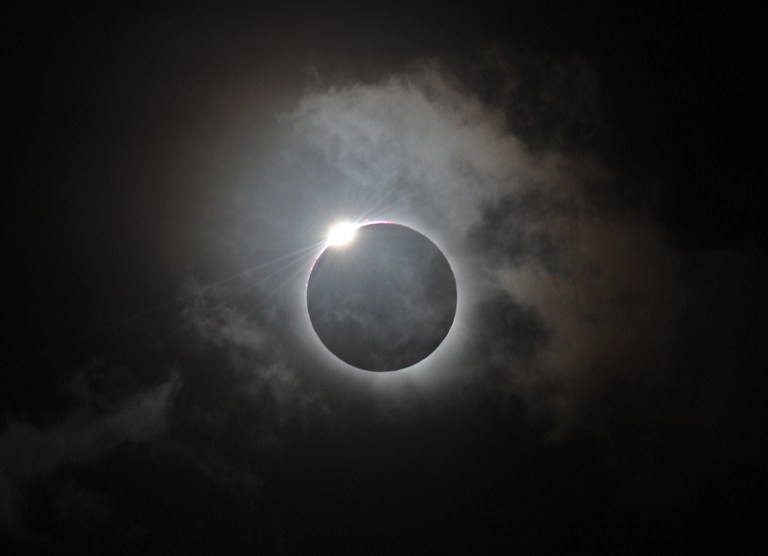SUMMARY
This is AI generated summarization, which may have errors. For context, always refer to the full article.

PALM COVE, Australia, – Sky-gazers in northern Australia donned protective glasses as the clouds parted Wednesday, November 14, to allow them to witness one of nature’s greatest phenomena — a total eclipse of the sun.
All eyes and cameras turned to the heavens over tropical north Queensland as the moon began moving between the Earth and the sun, like a small bite which gradually increases in size.
Cloud cover threatened to spoil the party and huge cheers erupted when they parted to give tens of thousands of eclipse hunters a perfect view of totality — when the moon completely covers the sun and a faint halo or corona appears.
“Wow, insects and birds gone quiet,” one tourist, Geoff Scott, tweeted. Another, Stuart Clark, said: “This it it. Totality now. Utterly beautiful.”
The path of the eclipse got under way shortly after daybreak when the moon’s shadow, or umbra, fell in the Garig Gunak Barlu National Park in the Northern Territory, about 250 kilometers (155 miles) east of Darwin.
The umbra then moved eastward before alighting in north Queensland — one of the few places it could be viewed by humans and where tourists and scientists flocked to witness the region’s first total solar eclipse in 1,300 years.
Totality lasted just over two minutes from 6.38am (2038 GMT Tuesday).
When it happened the early chatter of birds and animals was replaced by an eerie silence as the moon overtook the sun, casting a shadow that plunged the land into darkness, with temperatures dropping.
“Day into night, unbelievable, goosebumps, speechless, amazing,” said Palm Cove eclipse watcher Simon Crerar.
Fred Espenak, an American astrophysicist and world authority on eclipses, told the Australian Broadcasting Corporation that while eclipses can seem somehow magical, in fact they can be predicted accurately.
“Certainly within 100 to 200 years we can predict when an eclipse will occur to within a second,” he said.
“But the pattern of occurrence is a complicated one. They don’t repeat on a time schedule like the seasons of the year.”
He explained that when a total eclipse occurred “the darkest part of the moon’s shadow sweeps across the earth’s surface”.
“Total solar eclipses occur once every one to two years but are only visible from less than half a percent of the earth’s surface,” he said.
The rare spectacle, which was viewed live by millions around the world, drew thousands of eclipse tourists to Queensland with the state government estimating that 50,000-60,000 people made the trip.
They include three charter flights with 1,200 scientists from Japan while six cruise ships were moored off the coast and hot air balloons dotted the skies.
Accommodation was solidly booked — from five-star hotels to camping grounds.
Scientists will study the effects of the eclipse on the marine life of the Great Barrier Reef and Queensland’s rainforest birds and animals while psychologists will monitor the impact on humans.
Total eclipses can be seen from a given point on Earth’s surface only once every 410 years in the northern hemisphere, but only once every 540 years in the southern hemisphere.
The last total eclipse was on July 11, 2010, again over the South Pacific. The next will take place on March 20, 2015, occurring over Iceland, the Faroe Islands and Norway’s far northern Svalbard archipelago, according to Espenak. – Greg Wood, Agence France-Presse
Add a comment
How does this make you feel?
There are no comments yet. Add your comment to start the conversation.